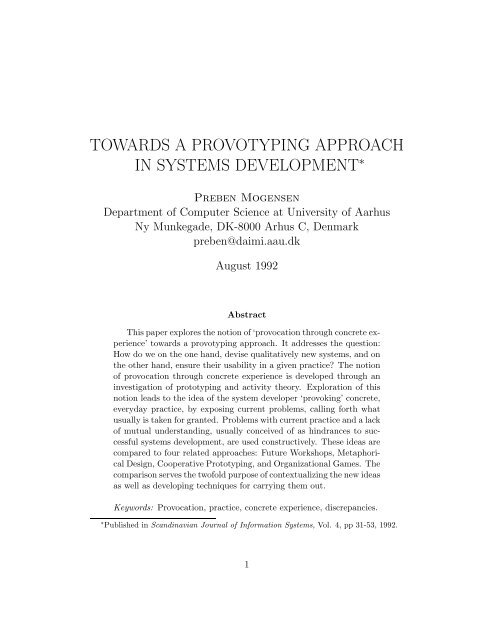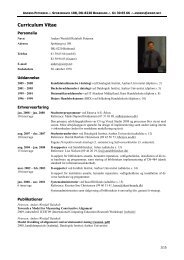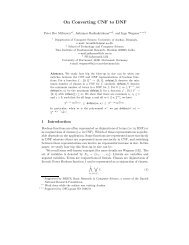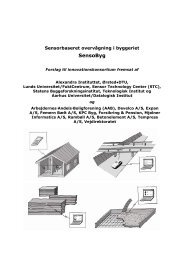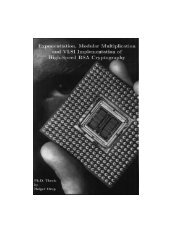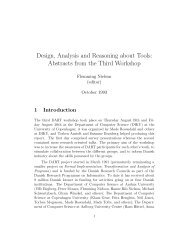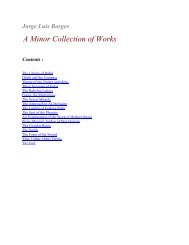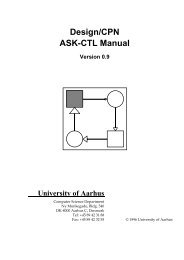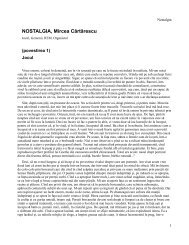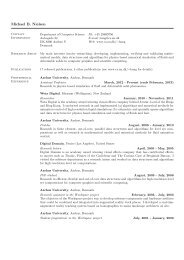towards a provotyping approach in systems development
towards a provotyping approach in systems development
towards a provotyping approach in systems development
Create successful ePaper yourself
Turn your PDF publications into a flip-book with our unique Google optimized e-Paper software.
TOWARDS A PROVOTYPING APPROACH<br />
IN SYSTEMS DEVELOPMENT ∗<br />
Preben Mogensen<br />
Department of Computer Science at University of Aarhus<br />
Ny Munkegade, DK-8000 Arhus C, Denmark<br />
preben@daimi.aau.dk<br />
August 1992<br />
Abstract<br />
This paper explores the notion of ‘provocation through concrete experience’<br />
<strong>towards</strong> a <strong>provotyp<strong>in</strong>g</strong> <strong>approach</strong>. It addresses the question:<br />
How do we on the one hand, devise qualitatively new <strong>systems</strong>, and on<br />
the other hand, ensure their usability <strong>in</strong> a given practice? The notion<br />
of provocation through concrete experience is developed through an<br />
<strong>in</strong>vestigation of prototyp<strong>in</strong>g and activity theory. Exploration of this<br />
notion leads to the idea of the systemdeveloper ‘provok<strong>in</strong>g’ concrete,<br />
everyday practice, by expos<strong>in</strong>g current problems, call<strong>in</strong>g forth what<br />
usually is taken for granted. Problems with current practice and a lack<br />
of mutual understand<strong>in</strong>g, usually conceived of as h<strong>in</strong>drances to successful<br />
<strong>systems</strong> <strong>development</strong>, are used constructively. These ideas are<br />
compared to four related <strong>approach</strong>es: Future Workshops, Metaphorical<br />
Design, Cooperative Prototyp<strong>in</strong>g, and Organizational Games. The<br />
comparison serves the twofold purpose of contextualiz<strong>in</strong>g the new ideas<br />
as well as develop<strong>in</strong>g techniques for carry<strong>in</strong>g themout.<br />
Keywords: Provocation, practice, concrete experience, discrepancies.<br />
∗ Published <strong>in</strong> Scand<strong>in</strong>avian Journal of Information Systems, Vol. 4, pp 31-53, 1992.<br />
1
1 Introduction<br />
Systems developers, engaged <strong>in</strong> develop<strong>in</strong>g new computer <strong>systems</strong> for an<br />
organization, are faced with a complex task. One reason for this complexity<br />
is the twofold nature of the demands on the system under <strong>development</strong>. On<br />
the one hand, it must fit <strong>in</strong>to and support exist<strong>in</strong>g practice, <strong>in</strong> order to be<br />
used. On the other hand, the very reason for engagement is the need for<br />
changes (<strong>in</strong>clud<strong>in</strong>g a new computer system).<br />
This problem is one <strong>in</strong>stance of the more general contradiction between<br />
tradition and transcendence. Pelle Ehn, <strong>in</strong> his doctoral thesis Work-oriented<br />
Design of Computer Artifacts (Ehn 1988), gives an account of some of the<br />
dimensions of this contradiction.<br />
One can focus on tradition or transcendence <strong>in</strong> the artifacts to<br />
be used. Should a word processor be designed as a traditional<br />
typewriter or as someth<strong>in</strong>g totally new? Another dimension is<br />
professional competence. Should the ‘old’ skills of typographers<br />
be what is designed for or should ‘new’ knowledge replace these<br />
skills <strong>in</strong> future use? Along the same dimension is division of labor<br />
and cooperation. Should the new design support the traditional<br />
organization <strong>in</strong> a compos<strong>in</strong>g room or suggest new ways of cooperation<br />
between typographers and journalists? There is also<br />
the contradiction between tradition and transcendence <strong>in</strong> the objects<br />
or use values to be produced. Should the design support<br />
the traditional services a library has produced or should it support<br />
completely new services and even new clients. Tradition or<br />
transcendence, that is the question <strong>in</strong> design. (Ehn 1988, p. 129)<br />
One can focus on tradition or transcendence, but the question is always<br />
that of tradition and transcendence—we are always to some degree bound <strong>in</strong><br />
our tradition and, at the same time, have to transcend the present <strong>in</strong> order<br />
to solve our problems.<br />
The dimensions <strong>in</strong> Ehn’s elaboration of the contradiction between tradition<br />
and transcendence each concerns what to develop. This paper focuses<br />
more on the problem of how to f<strong>in</strong>d out. In this respect the contradiction<br />
can be reformulated <strong>in</strong> more operational terms: How do we on the one hand,<br />
devise qualitativelynew <strong>systems</strong>, and on the other hand, ensure their usability<strong>in</strong><br />
the given practice. This is the basic question addressed <strong>in</strong> this paper.<br />
2
In order to delimit the scope of the paper with respect to the <strong>systems</strong> <strong>development</strong><br />
process, I will focus on the area where this question seems most<br />
important and most relevant: between <strong>in</strong>itial <strong>in</strong>vestigation and analysis of<br />
current practice and design 1 of new practices?<br />
The paper is organized as follows: In Section 2, prototyp<strong>in</strong>g and activity<br />
theory are <strong>in</strong>vestigated with respect to their potential contribution to the<br />
question raised. Prototyp<strong>in</strong>g addresses the question of ‘design<strong>in</strong>g for usability,’<br />
and activity theory addresses the question of us<strong>in</strong>g the present <strong>in</strong> the<br />
creation of the qualitatively new.<br />
In Section 3, the central ideas from these two sources—provocation through<br />
concrete experience—are explored <strong>in</strong> the area between <strong>in</strong>itial <strong>in</strong>vestigation<br />
and analysis of current practice and design of new practices. The ma<strong>in</strong> argument<br />
for undertak<strong>in</strong>g ‘provocation through concrete experience’ is first<br />
established through a discussion of the taken-for-grantedness of practice.<br />
The issues of what to provoke and who should do it are further explored<br />
through the issues of discrepancies <strong>in</strong> a practice and the <strong>systems</strong> developer<br />
as a provocateur.<br />
In Section 4, the ideas are compared to four related <strong>approach</strong>es: Future<br />
Workshops, Metaphorical Design, Cooperative Prototyp<strong>in</strong>g, and Organizational<br />
Games. The comparison serves the twofold purpose of contextualiz<strong>in</strong>g<br />
the ideas as well as f<strong>in</strong>d<strong>in</strong>g techniques for carry<strong>in</strong>g them out.<br />
2 Two Sources of Inspiration<br />
2.1 Prototyp<strong>in</strong>g<br />
The notion of prototyp<strong>in</strong>g <strong>in</strong> <strong>systems</strong> <strong>development</strong> emerged <strong>in</strong> the late 1970’s<br />
(Naumann & Jenk<strong>in</strong>s 1982, Bally et al. 1977) as a reaction aga<strong>in</strong>st more traditional<br />
phase-oriented models (e.g. l<strong>in</strong>ear models, life-cycle models, waterfall<br />
models etc.) of how to develop computer <strong>systems</strong> (Avison & Fitzgerald<br />
1988, Bally et al. 1977, Boehm 1988, Hekmatpour & Ince 1988, Lantz 1986).<br />
Two basic problems seem common to most of the critiques:<br />
• The idea of successive and well def<strong>in</strong>ed stages with fully elaborated,<br />
and thereafter ‘frozen,’ documents, e.g. the requirement specification,<br />
is rather illusory. This viewpo<strong>in</strong>t is taken by those emphasiz<strong>in</strong>g the ‘eng<strong>in</strong>eer<strong>in</strong>g’<br />
aspects (Lyyt<strong>in</strong>en 1987) of prototyp<strong>in</strong>g (Avison & Fitzgerald<br />
3
1988, Hekmatpour & Ince 1988, Lantz 1986)<br />
• The strategy of detached analysis of current organization and a logical<br />
design of the new, and the accomplishment of this strategy by<br />
‘<strong>systems</strong> developers’ only, are not enough to ensure system usability.<br />
This viewpo<strong>in</strong>t is taken by those emphasiz<strong>in</strong>g the participation<br />
and usability aspects of prototyp<strong>in</strong>g (Bødker 1987, Ehn 1988, Floyd<br />
1987, Grønbæk 1988), build<strong>in</strong>g on foundations <strong>in</strong>spired by, among others,<br />
Polanyi (1967, 1984), W<strong>in</strong>ograd and Flores (1986) and the later<br />
Wittgenste<strong>in</strong> (1958).<br />
The significance of these problems depends on the situation. The more<br />
uncerta<strong>in</strong> the situation, the more severe the two problems become. 2 Therefore,<br />
the drawbacks of more traditional <strong>approach</strong>es and the need for prototyp<strong>in</strong>g<br />
are issues most often raised <strong>in</strong> situations characterized by a high<br />
degree of uncerta<strong>in</strong>ty.<br />
The proposed solution to problems with the traditional <strong>approach</strong>es—<br />
prototyp<strong>in</strong>g—seems to vary<strong>in</strong>g degrees to be based on three characteristics<br />
(Bannon & Bødker 1991, Bødker 1987, Boødker & Grønbæk 1989, Boehm<br />
1988, Ehn 1988, Floyd 1984, Floyd 1987, Hekmatpour & Ince 1988, Naumann<br />
& Jenk<strong>in</strong>s 1982, Wilson & Rosenberg 1988):<br />
• Prototyp<strong>in</strong>g is primarily directed <strong>towards</strong> construction of the future. In<br />
prototyp<strong>in</strong>g one makes prototypes, ‘types’ that are prelim<strong>in</strong>ary versions<br />
of potential computer <strong>systems</strong>. 3<br />
• The need for iteration is taken seriously and is considered a constitutive<br />
part of prototyp<strong>in</strong>g. Somewhat simplified, the prototyp<strong>in</strong>g process can<br />
be described as: to ‘guess’ at one or more potential solutions; partly<br />
implement these ideas; apply/test the result<strong>in</strong>g prototypes: and, on<br />
this basis, construct a new (and hopefully better) ‘guess’—whereupon<br />
the process can start over aga<strong>in</strong>.<br />
• Prospective users are enabled and encouraged to get concrete experience<br />
with the prospective computer system by us<strong>in</strong>g the various prototypes.<br />
In order to assess, for <strong>in</strong>stance, the usefulness and usability of a<br />
computer application, one must use it <strong>in</strong> the given context—get ‘hands<br />
on’. This implies, <strong>in</strong> pr<strong>in</strong>ciple, that one cannot assess the prospective<br />
computer system before it is f<strong>in</strong>ished. The prototyp<strong>in</strong>g <strong>approach</strong><br />
4
tries to overcome this contradiction by the construction of a number of<br />
prelim<strong>in</strong>ary programs, thus gradually mak<strong>in</strong>g the future more concrete.<br />
Prototyp<strong>in</strong>g, naturally, has its strengths and weaknesses depend<strong>in</strong>g on the<br />
context: design of user <strong>in</strong>terfaces, technical ‘eng<strong>in</strong>eer<strong>in</strong>g,’ general <strong>approach</strong><br />
to <strong>systems</strong> <strong>development</strong>, etc. Assessments can be found <strong>in</strong> (Bødker 1987,<br />
Floyd 1984, Hekmatpour & Ince 1988, Naumann & Jenk<strong>in</strong>s 1982, Wilson<br />
& Rosenberg 1988). Here, I restrict myself to strengths and weaknesses of<br />
prototyp<strong>in</strong>g as a potential (partial) solution to the problem <strong>in</strong> focus <strong>in</strong> this<br />
paper: How to get from <strong>in</strong>vestigation and analysis of current practice to<br />
design of new pracitices.<br />
From this perspective, the emphasis on concrete contextualized experience<br />
and on the prototype as concrete medium is def<strong>in</strong>itely a strength. If<br />
learn<strong>in</strong>g through concrete experience is important with respect to the design<br />
of future means (computer <strong>systems</strong>), it must be equally important with<br />
respect to <strong>in</strong>vestigation of current means, whether computerized or not.<br />
Still, prototyp<strong>in</strong>g needs to be expanded <strong>in</strong> order to solve the problems<br />
<strong>in</strong> the area between <strong>in</strong>vestigation of current practice and design of new<br />
pracitices:<br />
• First of all, prototyp<strong>in</strong>g is directed <strong>towards</strong> the future (potential computer<br />
applications). It does not normally consider how the new application<br />
can be based on current practice. On the one hand, current<br />
practice imposes a number of constra<strong>in</strong>ts on potential applications.<br />
On the other hand, current practice often conta<strong>in</strong>s the keys to what<br />
‘guesses’ could be appropriate.<br />
• Before the process of prototyp<strong>in</strong>g can be <strong>in</strong>itiated, the participants<br />
must have some basic overall idea of what to develop. Otherwise, it is<br />
almost impossible to make the <strong>in</strong>itial ‘guesses’ that constitute the start<br />
of a prototyp<strong>in</strong>g process.<br />
• In the strategy of successive prototypes lies a danger of bl<strong>in</strong>dness (‘tunnel<br />
vision’) (Sol 1984), ‘model effect’ (Bally et al. 1977). Once the process<br />
of <strong>development</strong> of successive prototypes has started, the danger<br />
arises that one is led to elaborate the details of the current prototype<br />
<strong>in</strong>stead of question<strong>in</strong>g its underly<strong>in</strong>g premises. In the process, what was<br />
<strong>in</strong>itially questioned becomes more and more taken for granted, and it<br />
becomes more and more difficult to consider radical changes. 4 To what<br />
5
extent this is a danger to be avoided naturally depends on whether one<br />
is on the ‘right’ track or not, which aga<strong>in</strong> underscores the importance<br />
of the <strong>in</strong>itial ‘guesses’.<br />
• Prototyp<strong>in</strong>g provides very few concepts and techniques for understand<strong>in</strong>g<br />
and handl<strong>in</strong>g the collective aspects: <strong>in</strong>vestigation of current practice<br />
and design of new practices is most often accomplished by a collection<br />
of people as well as for a collection of people. 5<br />
Thus, as a tool to get from the current to a preferable future practice, the<br />
idea from prototyp<strong>in</strong>g of learn<strong>in</strong>g through concrete experience can be used.<br />
However, the issues of bas<strong>in</strong>g the visions <strong>in</strong> current practice, overcom<strong>in</strong>g<br />
bl<strong>in</strong>dness, and handl<strong>in</strong>g the collective aspects rema<strong>in</strong>.<br />
2.2 Activity Theory<br />
Activitytheory, as <strong>in</strong>terpreted by Yrjö Engeström <strong>in</strong> Learn<strong>in</strong>g byExpand<strong>in</strong>g<br />
(1987) and Learn<strong>in</strong>g, Work<strong>in</strong>g and Imag<strong>in</strong><strong>in</strong>g (1990b), and further elaborated<br />
with respect to <strong>systems</strong> <strong>development</strong> by Bisgaard et al. (1989a, 1989b),<br />
explicitly addresses these issues.<br />
Engeström takes his po<strong>in</strong>t of departure <strong>in</strong> what he calls the futilityof<br />
learn<strong>in</strong>g.<br />
The problem is that problem solv<strong>in</strong>g and structur<strong>in</strong>g are esentially<br />
reactive forms of learn<strong>in</strong>g. Both presuppose a given context<br />
which presents the <strong>in</strong>dividual with a preset learn<strong>in</strong>g task.<br />
Learn<strong>in</strong>g is def<strong>in</strong>ed so as to exclude the possibility of f<strong>in</strong>d<strong>in</strong>g or<br />
creat<strong>in</strong>g new contexts. However, it is this very aspect of human<br />
performance—or rather the lack of it—that is becom<strong>in</strong>g the central<br />
source of uneas<strong>in</strong>ess and trouble <strong>in</strong> various fields of societal<br />
practice. (Engeström 1987, p.2)<br />
What Engeström suggests is that practitioners (those engaged <strong>in</strong> the practice<br />
<strong>in</strong> question) should themselves be enabled to f<strong>in</strong>d or create new contexts.<br />
F<strong>in</strong>d<strong>in</strong>g or creat<strong>in</strong>g qualitatively new contexts is what Engeström calls expansion.<br />
This, however, <strong>in</strong>troduces a problem similar to the one addressed<br />
<strong>in</strong> this paper: How does one create a qualitatively new practice and ensure<br />
that it is founded <strong>in</strong> the current, historically developed practice?<br />
6
In deal<strong>in</strong>g with this question (as well as others) Engeström develops an<br />
extensive conceptual framework based on cultural-historical theory of activity.<br />
In order to give the reader an <strong>in</strong>itial grasp of this framework, some of<br />
the ma<strong>in</strong> po<strong>in</strong>ts are highlighted.<br />
Activity<br />
In activity theory, a dist<strong>in</strong>ction is made among different levels of human<br />
agency: operations, actions, and activity. Operations are unconscious and<br />
triggered by conditions: when I write my signature, for <strong>in</strong>stance, I am not<br />
aware of how I write the <strong>in</strong>dividual letters. Actions are conscious and directed<br />
<strong>towards</strong> fulfilment of goals: I am conscious of what I write, e.g. my signature,<br />
and its purpose, e.g. sign<strong>in</strong>g a document. These are two levels of an <strong>in</strong>dividual’s<br />
agency. The third, activity, refers to the question of why an action is<br />
performed . In order to answer that, one has to take <strong>in</strong>to consideration the<br />
entire collective activity, i.e. the culturally established traditions, rules, and<br />
mean<strong>in</strong>gs operat<strong>in</strong>g <strong>in</strong> the situation, e.g. the legal implications of writ<strong>in</strong>g<br />
one’s signature, and that sign<strong>in</strong>g a document often means enter<strong>in</strong>g <strong>in</strong>to a<br />
contract. Consider, for example, a primeval collective hunt. 6 An <strong>in</strong>dividual<br />
member of the group may perform the action of driv<strong>in</strong>g a herd of animals<br />
<strong>towards</strong> the other hunters. If the overall purpose, the ‘motive,’ is to collect<br />
food and clothes then this action of the <strong>in</strong>dividual member seems mean<strong>in</strong>gless,<br />
and even self-destructive (frighten<strong>in</strong>g away the animals <strong>in</strong>stead of kill<strong>in</strong>g<br />
them). Only when we take <strong>in</strong>to consideration the division of labour, rules,<br />
and traditions of the collective activity does this <strong>in</strong>dividual action become,<br />
<strong>in</strong>deed, very mean<strong>in</strong>gful. Activity is collective and directed <strong>towards</strong> the fulfilment<br />
of a motive (e.g. gett<strong>in</strong>g food and clothes), and realized through the<br />
<strong>in</strong>dividual actions (e.g. frighten<strong>in</strong>g off the herd), which <strong>in</strong> turn are carried<br />
out through unconscious operations (e.g. clapp<strong>in</strong>g the hands).<br />
Mediatedness<br />
Any truly human action is analyzed as a mediated structure. Instead of a dualistic<br />
subject-object structure, human behaviour is seen as a triad, consist<strong>in</strong>g<br />
of the subject, object, and mediat<strong>in</strong>g <strong>in</strong>struments—tools, signs, traditions,<br />
theories, methods, techniques, etc. Consider, for example, the relation between<br />
subject and object <strong>in</strong> the case of hammer<strong>in</strong>g a nail <strong>in</strong>to a piece of wood.<br />
Clearly, the direction from subject to object (the fulfilment of the subject’s<br />
7
<strong>in</strong>tention with the object) is mediated by the hammer. Equally important,<br />
however, is the opposite direction from object to subject: how does the subject<br />
experience the object? Issues such as the relative hardness of nail, wood,<br />
and steel (the head of the hammer) are difficult to establish without hammers<br />
or similar <strong>in</strong>struments; to the touch, wood, nails, and steel feel equally<br />
hard (assum<strong>in</strong>g we are talk<strong>in</strong>g about fresh and hard wood). Likewise, when<br />
we broaden the scope from an <strong>in</strong>dividual action to a collective activity the<br />
mediated structure persists, as illustrated by Engeström’s triangle depict<strong>in</strong>g<br />
the structure of human activity (Figure 1).<br />
Figure 1: Engeström’s triangle depict<strong>in</strong>g the structure of human activity<br />
The subject’s relation to the community is mediated by rules, <strong>in</strong> this<br />
context a broad concept encompass<strong>in</strong>g language, rituals, what is usually<br />
called rules, norms, etc. The relation between the community and the object<br />
(the work to be done) is mediated by the work organization: the community<br />
seen as a whole accomplishes the work to be done by delegat<strong>in</strong>g sub-tasks to<br />
<strong>in</strong>dividual members.<br />
Contradictions<br />
The basic idea is that any activity is subject to both <strong>in</strong>ternal and external<br />
contradictions, and that these contradictions are the primary forces beh<strong>in</strong>d<br />
<strong>development</strong>. In Learn<strong>in</strong>g byExpand<strong>in</strong>g, contradictions are, to a great extent,<br />
treated <strong>in</strong> the context of dialectical materialism, and expla<strong>in</strong>ed through<br />
concepts like commodity, exchange value, and use value. As a consequence,<br />
8
contradictions have an almost ontological status—they objectively exist <strong>in</strong>dependent<br />
of the <strong>in</strong>dividual subject. In short, <strong>development</strong> is conceived <strong>in</strong><br />
the context of a dialectic resembl<strong>in</strong>g that of the later Hegel: Society is a<br />
dialectic totality, and <strong>development</strong> is <strong>in</strong> reaction to contradictions. But, contrary<br />
to the Marxian notion that we can reach a harmonious end of history,<br />
we can never overcome contradictions as such; whenever some contradictions<br />
are resolved, others arise.<br />
The cycle of expansive <strong>development</strong><br />
Expansive <strong>development</strong> is proposed as a means to handle the problem of<br />
the futility of learn<strong>in</strong>g, and is thought of as facilitated by ‘researchers’. The<br />
<strong>approach</strong> can be summarized as follows:<br />
1. perform historical analyses of the activity <strong>in</strong> question, and of the contradictions<br />
that prompted its <strong>development</strong>;<br />
2. elaborate current activity by expos<strong>in</strong>g it to these contradictions;<br />
3. on this basis, (hopefully) get the first ideas for a new activity;<br />
4. envision an expanded activity—creat<strong>in</strong>g new contexts—with the help<br />
of spr<strong>in</strong>gboards (<strong>in</strong>novative techniques);<br />
5. elaborate this vision and try it out <strong>in</strong> a microcosm;<br />
6. cope with the fact that the result is almost always unexpected, and<br />
that new contradictions arise;<br />
7. eventually start a new cycle;<br />
Thus, <strong>development</strong> is founded <strong>in</strong> the historically developed practice, and<br />
contradictions are seen as a resource rather than someth<strong>in</strong>g to be avoided or<br />
brushed aside.<br />
In relation to the focus <strong>in</strong> this paper, activity theory, also, has its strengths<br />
and weaknesses.<br />
Tak<strong>in</strong>g the weaknesses first:<br />
9
• The emphasis <strong>in</strong> the cycle of expansive <strong>development</strong>, up to the po<strong>in</strong>t<br />
where a new expanded activity is envisioned, is on detached analysis<br />
by researchers. Concrete experience, which activity theory—like<br />
prototyp<strong>in</strong>g—generally stresses, is not utilized <strong>in</strong> these early activities.<br />
• The potential operative means, the cycle of expansive <strong>development</strong>, is<br />
too abstract. It is a general psychological and social methodology, not<br />
a methodology for <strong>systems</strong> <strong>development</strong>.<br />
• The framework of dialectical materialism tends to give contradictions<br />
an ontological status they do not deserve. Even to the extent that contradictions<br />
act merely as epistemological <strong>in</strong>struments, they are usually<br />
overemphazised and thus overshadow other perspectives.<br />
As for its strengths, activity theory does provide an <strong>in</strong>strument for understand<strong>in</strong>g<br />
the connection between <strong>in</strong>dividuals and the practice <strong>in</strong> which they<br />
are engaged—activity. Likewise, it provides an understand<strong>in</strong>g of how a new<br />
practice can be founded <strong>in</strong> present and past ones. Despite the problems with<br />
the notion of contradiction, the idea of utiliz<strong>in</strong>g contradictions as a resource<br />
rather than avoid<strong>in</strong>g them or brush<strong>in</strong>g them aside is very attractive.<br />
3 Provocation Through Concrete Experience<br />
Return<strong>in</strong>g to the question posed <strong>in</strong> the <strong>in</strong>troduction—How do we, on the<br />
one hand, devise qualitatively new <strong>systems</strong>, and, on the other hand, ensure<br />
their usability <strong>in</strong> the given practice?—the contributions from prototyp<strong>in</strong>g<br />
and activity theory can be summarized. The idea from activity theory is<br />
to create the new by expos<strong>in</strong>g problems <strong>in</strong> current practice: to provoke.<br />
Provocation is here and <strong>in</strong> the rest of the paper used <strong>in</strong> the senses: (a) when<br />
the provoked is not a person: “to call forth, <strong>in</strong>voke, to summon, <strong>in</strong>vite”;<br />
when (b) when the provoked is a person: “to <strong>in</strong>cite or urge...to some act or<br />
to do someth<strong>in</strong>g, to stimulate to action.” 7 The idea from prototyp<strong>in</strong>g is to<br />
provoke by actually try<strong>in</strong>g out the situations <strong>in</strong> which these problems emerge:<br />
provok<strong>in</strong>g through concrete experience. As stated <strong>in</strong> the <strong>in</strong>troduction, the<br />
focus is on the area where the question of what qualitatively new <strong>systems</strong><br />
to build versus their usability <strong>in</strong> current practice seems most important and<br />
most relevant: between <strong>in</strong>itial <strong>in</strong>vestigation of current practice and design of<br />
new practices.<br />
10
In the follow<strong>in</strong>g three sections, these ideas will be explored <strong>in</strong> relation to<br />
the questions of ‘why,’ ‘what,’ and ‘who,’ focus<strong>in</strong>g on issues where the ideas<br />
from prototyp<strong>in</strong>g and activity theory seem to provide new understand<strong>in</strong>g<br />
rather than address<strong>in</strong>g the questions <strong>in</strong> general.<br />
3.1 Why Provocation: The Taken-for-Grantedness of<br />
Practice<br />
In order to take current problems as po<strong>in</strong>ts of departure,we must first get<br />
hold of these problems. As will be argued, however, current practice and its<br />
problems are to a large extent taken for granted, i.e. they are ‘<strong>in</strong>visible’. In<br />
order to handle a problem it must somehow become more ‘visible’. It is to<br />
this end, that provocation through concrete experience is proposed.<br />
Regard<strong>in</strong>g the <strong>in</strong>dividual handl<strong>in</strong>g of an artifact, an <strong>in</strong>strument <strong>in</strong> Engeström’s<br />
terms, it is widely recognized that the artifact, <strong>in</strong> use, becomes ‘<strong>in</strong>visible’<br />
(W<strong>in</strong>ograd & Flores 1986, Heidegger 1979, Ehn 1988, Polanyi 1984).<br />
This is one of the reasons why prototyp<strong>in</strong>g encourages try<strong>in</strong>g out the handl<strong>in</strong>g<br />
of the artifact <strong>in</strong> order to get concrete experience. In the term<strong>in</strong>ology<br />
of activity theory: when a subject performs an action, the focus is on the<br />
object—the what—not the handl<strong>in</strong>g of the mediat<strong>in</strong>g <strong>in</strong>strument—the operations,<br />
the how. The <strong>in</strong>strument becomes ‘<strong>in</strong>visible’.<br />
Consider<strong>in</strong>g practices, activity theory provides an explanation of ‘<strong>in</strong>visibility’<br />
of more general mediators, such as rules, work organization, language.<br />
When we move from the level of <strong>in</strong>dividual action to the level of collective<br />
activity, we have to deal with the how (operations), the what (actions) and<br />
the why (activity). The reason for <strong>in</strong>troduc<strong>in</strong>g the level of activity was exactly<br />
to be able to answer the why question; the actions of the <strong>in</strong>dividual<br />
‘hunter’ frighten<strong>in</strong>g the animals seemed senseless without consider<strong>in</strong>g the entire<br />
activity. Why is this good (or bad), why is it done the way it is, why is it<br />
done at all, etc., all become central questions when problems <strong>in</strong> the exist<strong>in</strong>g<br />
practice are of concern.<br />
An explanation of the <strong>in</strong>visibility or taken-for-grantedness of practice can<br />
be found <strong>in</strong> the mean<strong>in</strong>g of mediatedness <strong>in</strong> activity theory. Instruments,<br />
rules and work organization are all mediators. Instruments—on the level<br />
of activity these are k<strong>in</strong>ds of ideologies—mediate primarily between subject<br />
and object; rules, <strong>in</strong> the broad sense of the word <strong>in</strong>clud<strong>in</strong>g language, between<br />
subject and community; and work-organization between community<br />
11
and object.<br />
In our everyday practice we usually communicate with others by focus<strong>in</strong>g<br />
on the object of conversation, not the words used: We act accord<strong>in</strong>g<br />
to the rules, norms, and values prescrib<strong>in</strong>g proper behaviour <strong>in</strong> the given<br />
community, we usually do not discuss or contemplate them. In the act of<br />
collaborative work, meta-questions concern<strong>in</strong>g participants’ roles and qualifications<br />
rarely surface. In this respect, rules, language, work-organization,<br />
and ideologies, function to a large degree as artifacts <strong>in</strong> <strong>in</strong>dividual use <strong>in</strong><br />
that they mediate between the subject and what is <strong>in</strong> focus, and thus, they<br />
become transparent and taken for granted. Moreover, it is only by virtue of<br />
this taken-for-grantedness that they function properly.<br />
To a large extent, answers to the whyquestions are taken for granted—<br />
they are ‘<strong>in</strong>visible’. In everyday life, engaged <strong>in</strong> different practices, we do not<br />
constantly ask ourselves questions about why we do the th<strong>in</strong>gs we normally<br />
do. And there are good reasons for this: we would not be able to do much<br />
else, and would probably end up <strong>in</strong> ‘existential crisis’.<br />
Bødker & Pedersen (1991), also address the question of the taken-forgrantedness<br />
of practice. They expla<strong>in</strong> the phenomenon <strong>in</strong> terms of ‘culture’<br />
or ‘<strong>systems</strong> of mean<strong>in</strong>g’ and formulate it as follows:<br />
The workplace is seen as be<strong>in</strong>g a culture. The values and beliefs of<br />
the culture are understood to have grown out of experience, and<br />
are conceptualized as a system of mean<strong>in</strong>gs underly<strong>in</strong>g artifacts,<br />
symbols, and work practices. Although referred to as a system,<br />
the culture is not explicit but implicit; that is, hidden beh<strong>in</strong>d or<br />
<strong>in</strong> the various artifacts, symbols, workrout<strong>in</strong>es, and established<br />
patterns of cooperation. (Bødker & Pedersen 1991)<br />
Edgar H. Sche<strong>in</strong> <strong>in</strong> Organizational Culture and Leadership—A Dynamic<br />
View (1985) def<strong>in</strong>es culture, his object of study, as the shared basic assumptions<br />
and convictions that are taken for granted because they repeatedly function<br />
<strong>in</strong> the everyday practice. Argyris & Schön <strong>in</strong> Organizational Learn<strong>in</strong>g:<br />
A Theoryof Action Perspective (1978) emphasize the dist<strong>in</strong>ction between<br />
the implicit assumptions that guide an organization’s actual performance,<br />
theory-<strong>in</strong>-use, and the explicit reasons, what it ‘says’ it does or is supposed<br />
to do, espoused theory.<br />
Thus, when the issue is that of utiliz<strong>in</strong>g current problems as a resource<br />
<strong>in</strong> the <strong>development</strong> of a new practice, we cannot accept these problems at<br />
12
their ‘face value’. We must go deeper. We have to understand some of the<br />
why’s and how’s. These questions cannot be answered by observation alone<br />
(this yields the what and perhaps the how, but not the why), nor by ask<strong>in</strong>g<br />
only <strong>in</strong>dividuals, we have to ‘ask’ the practice.<br />
3.2 What to Provoke: Discrepancies <strong>in</strong> a Practice<br />
As mentioned, activity theory suggests the idea of creat<strong>in</strong>g the new by expos<strong>in</strong>g<br />
current problems. Therefore, <strong>in</strong>spired by activity theory, three general<br />
types of potential problems are presented. In what follows, the examples<br />
are from an ongo<strong>in</strong>g project between the Computer Science Department <strong>in</strong><br />
Aarhus and a branch of the National Labour Inspection Service (NLIS).<br />
Discrepancies between different goals. Engeström, build<strong>in</strong>g on Marx,<br />
argues that these discrepancies are caused by contradictions between<br />
the use value and the exchange value of commodities produced by the<br />
practice. More generally, these discrepancies often stem from the fact<br />
that people are, at the same time, engaged <strong>in</strong> several practices with<br />
different goals (e.g. the practice of the local branch, the practice of<br />
the whole organization, the practice of family life, etc.). In NLIS the<br />
<strong>in</strong>spectors, on the one hand, try to ensure safety of the work environment<br />
by discuss<strong>in</strong>g with workplace representatives what is wrong and<br />
how the situation could be improved, etc. On the other hand, what<br />
is demanded from the central organization <strong>in</strong> NLIS is measurable data<br />
about the work <strong>in</strong> order to legitimate the organization politically, e.g.<br />
time spent <strong>in</strong> the field on workplaces, number of workplaces visited,<br />
and number of charges made. Thus, if the <strong>in</strong>spectors do their jobs<br />
‘properly’ by spend<strong>in</strong>g time <strong>in</strong> discussion with the workplace representatives,<br />
their performance accord<strong>in</strong>g to the statistics delivered to the<br />
central organization will decrease.<br />
Discrepancies between different elements of the practice. In Figure<br />
1, a practice is depicted as an entirety of: subjects act<strong>in</strong>g; tasks to<br />
be performed; means of perform<strong>in</strong>g them; organization of work; rules,<br />
language, traditions, and norms; communities; and objectives. Rather<br />
than constitut<strong>in</strong>g a ‘synthesis,’ these elements often ‘counteract’ one<br />
another. For example, <strong>in</strong>troduc<strong>in</strong>g new work tasks while reta<strong>in</strong><strong>in</strong>g old<br />
<strong>in</strong>struments to accomplish them may <strong>in</strong>troduce discrepancies between<br />
13
the new tasks and the old <strong>in</strong>struments; the <strong>in</strong>troduction of new computer<br />
applications can result <strong>in</strong> discrepancies between these and the<br />
old division of labour; <strong>in</strong>tended rules of safety rout<strong>in</strong>es can be <strong>in</strong> opposition<br />
to the need to get th<strong>in</strong>gs done. In NLIS, to a large degree, work<br />
is organized accord<strong>in</strong>g to the <strong>in</strong>spectors’ trades: i.e. health-worker,<br />
craftsman, eng<strong>in</strong>eer, etc. But the objects of their work, workplaces,<br />
display problems <strong>in</strong> all these areas. Hence, the <strong>in</strong>spectors either encounter<br />
problems they lack the competence to solve, or they do not<br />
notice the problems at all.<br />
Discrepancies between actual and prescribed practice. Argyris &<br />
Schön (1978) conceptualize this discrepancy as the difference between<br />
espoused theory and theory-<strong>in</strong>-iuse, see Section 3.1. Engeström perceives<br />
the discrepancy <strong>in</strong> a historical light and calls it a contradiction<br />
between an old and a new activity. In general, every organization formulates<br />
procedures, rules, divisions of labour, etc. for what should be<br />
done, how and why. Often, this differs considerably from what is actually<br />
go<strong>in</strong>g on. An organization may ‘decide’ on a new way of do<strong>in</strong>g<br />
th<strong>in</strong>gs (new company policy, <strong>in</strong>troduction of new computer <strong>systems</strong>,<br />
etc.), but this does not necessarily mean that the decision is <strong>in</strong> fact<br />
effective: that those <strong>in</strong>volved actually act accord<strong>in</strong>g to the new way.<br />
In any practice, one can probably f<strong>in</strong>d many remnants of old practices.<br />
In NLIS, for example, a reorganization was carried out, as a<br />
response to the discrepancy between the organization accord<strong>in</strong>g to the<br />
trades of the <strong>in</strong>spectors and the object of their work. The organization<br />
shifted to a structure based on autonomous groups with the <strong>in</strong>tention<br />
that organizations of a given type should now be treated by a s<strong>in</strong>gle<br />
group. It turned out that many of the <strong>in</strong>spectors (the oldtimers) had a<br />
conception of their role as a ‘lonely cowboy’ (their expression), a remnant<br />
from the old practice counteract<strong>in</strong>g the new group-based practice<br />
(Markussen 1992).<br />
New computer <strong>systems</strong> are <strong>in</strong>evitably confronted by discrepancies <strong>in</strong> the<br />
current practice, usually result<strong>in</strong>g <strong>in</strong> the system not be<strong>in</strong>g used as <strong>in</strong>tended.<br />
An example (Bisgaard et al. 1989a, p. 71): <strong>in</strong> a public office <strong>in</strong> Denmark<br />
the rules held that a certa<strong>in</strong> type of transaction (provid<strong>in</strong>g the customers<br />
with loans) could only be carried out semi-annually; this was implemented<br />
<strong>in</strong> the new account<strong>in</strong>g system. However, a long-last<strong>in</strong>g practice had been to<br />
14
provide customers with these loans whenever they needed them. As a result,<br />
the employees actually did the account<strong>in</strong>g manually, followed by a transfer<br />
of the <strong>in</strong>formation to the system every six months.<br />
The idea from activity theory is to try to turn the question of discrepancies<br />
upside down, tak<strong>in</strong>g the discrepancies as a start<strong>in</strong>g po<strong>in</strong>t, with the purpose<br />
of transcend<strong>in</strong>g them, rather than deal<strong>in</strong>g with them afterwards.<br />
3.3 Who Provokes: The Systems Developer as Provocateur<br />
If we consider a situation <strong>in</strong> which <strong>systems</strong> developers enter a given practice <strong>in</strong><br />
order to develop a new application, the idea of provocation through concrete<br />
experience seems to provide two new perspectives: the role of ‘the <strong>systems</strong><br />
developer as provocateur,’ and what could be called ‘active use of lack of<br />
mutual understand<strong>in</strong>g’.<br />
The role of the provocateur can be characterized by dist<strong>in</strong>guish<strong>in</strong>g between<br />
three ideal types (imag<strong>in</strong>ed extremes) reflect<strong>in</strong>g the roles of the system<br />
developer <strong>in</strong> traditional <strong>systems</strong> <strong>development</strong>, prototyp<strong>in</strong>g, and provocation<br />
through concrete experience. Imag<strong>in</strong>e the practitioners—those engaged <strong>in</strong><br />
the practice to be developed—as on a journey. The dist<strong>in</strong>ction is made as<br />
to the location of the <strong>systems</strong> developer <strong>in</strong> front of, beside, or beh<strong>in</strong>d the<br />
practitioners.<br />
• As an expert, the system developer <strong>in</strong>vestigates different possibilities,<br />
f<strong>in</strong>ds out which one is best, and presents the solution to the practitioners<br />
as the route to follow. This role resembles the role of a ‘traditional’<br />
<strong>systems</strong> developer enter<strong>in</strong>g a practice encompass<strong>in</strong>g problems, mak<strong>in</strong>g<br />
surveys, suggest<strong>in</strong>g solutions, and so forth. The expert can be said to<br />
stand <strong>in</strong> front of the practitioners outl<strong>in</strong><strong>in</strong>g the way to go.<br />
• As a facilitator, the system developer outl<strong>in</strong>es possibilities and supports<br />
the practitioners with techniques to explore these possibilities.<br />
This role partly resembles that of a <strong>systems</strong> developer <strong>in</strong> participatory<br />
<strong>systems</strong> <strong>development</strong>. In exploratory prototyp<strong>in</strong>g, for example, the<br />
goal is to provide alternatives for the practitioners to try out (Floyd<br />
1984). The facilitator can be said to stand beside the practitioners,<br />
supply<strong>in</strong>g them with the means to f<strong>in</strong>d out for themselves which way<br />
to go.<br />
15
• As a provocateur, the system developer <strong>in</strong>vestigates the present and<br />
past <strong>in</strong> order to help the practitioners experience what is wrong with<br />
the present before mak<strong>in</strong>g decisions about the future. The provocateur<br />
urges or <strong>in</strong>vites realization—both <strong>in</strong> the sense of becom<strong>in</strong>g aware of<br />
and <strong>in</strong> the sense of mak<strong>in</strong>g real—of current problems <strong>in</strong> order to decide<br />
what is needed <strong>in</strong> the future. This role is the ideal type <strong>in</strong> provocation<br />
through concrete experience. In this respect, the provocateur can be<br />
said to stand beh<strong>in</strong>d the practitioners supply<strong>in</strong>g the means to f<strong>in</strong>d out<br />
about the present <strong>in</strong> order to know what to look for and what to avoid<br />
<strong>in</strong> a future.<br />
Which role to choose depends on the concrete situation. Us<strong>in</strong>g the ideal<br />
types, one can explore which ideal roles to choose <strong>in</strong> what ideal situations. If<br />
the situation is one <strong>in</strong> which it is possible ‘objectively’ to decide beforehand<br />
what might characterize a satisfactory solution (speed up the word process<strong>in</strong>g;<br />
create statistics over the number of books registered <strong>in</strong> our system; transform<br />
files <strong>in</strong> this format <strong>in</strong>to files of that format; etc.), the most suitable role<br />
is most likely the one of an expert—assum<strong>in</strong>g the necessary competence is<br />
present. If the situation is one <strong>in</strong> which we cannot f<strong>in</strong>d such ‘objective’ criteria,<br />
when the question <strong>in</strong>volves usefulness, hand<strong>in</strong>ess, ‘contributory-ness,’ fitness<br />
etc., the most suitable role is likely to be facilitator or provocateur. The<br />
choice depends on the extent to which the problems are known beforehand.<br />
When the situation is one of problem elaboration or problem ‘def<strong>in</strong>ition’—we<br />
know that someth<strong>in</strong>g is wrong, but not what or why—the <strong>approach</strong> taken,<br />
as I have argued above, should be provocation through concrete experience,<br />
with the system developer as a provocateur. When the problems are (more<br />
or less) known, and the <strong>approach</strong> taken is directed <strong>towards</strong> possible solutions,<br />
the suitable role is likely to be facilitator.<br />
Furthermore, the idea of provocation yields a new perspective on the<br />
degree to which the <strong>systems</strong> developer needs knowledge about the field he/she<br />
<strong>in</strong>vestigates; one ‘half’ of the issue of mutual understand<strong>in</strong>g. Lack of mutual<br />
understand<strong>in</strong>g between practitioners and <strong>systems</strong> developers is most often<br />
seen as a h<strong>in</strong>drance to jo<strong>in</strong>t <strong>systems</strong> <strong>development</strong>. Ehn & Kyng, for example,<br />
have suggested that designers, <strong>in</strong> an attempt to acquire some degree of mutual<br />
understand<strong>in</strong>g, should spend a year or two gett<strong>in</strong>g acqua<strong>in</strong>ted with a new<br />
area before do<strong>in</strong>g actual design (Ehn & Kyng 1987). From the perspective<br />
of provocation through experience this issue is perceived differently:<br />
16
• By obta<strong>in</strong><strong>in</strong>g mutual understand<strong>in</strong>g, a mutual ‘bl<strong>in</strong>dness,’ i.e. a mutual<br />
taken-for-grantedness, is acquired as well. One runs the risk of<br />
becom<strong>in</strong>g unable to see the forest for the trees.<br />
• Instead the idea is actively to utilize—<strong>in</strong>itial—lack of mutual understand<strong>in</strong>g.<br />
In order to provoke a practice, it is often more fruitful to<br />
come from the outside with different viewpo<strong>in</strong>ts, than com<strong>in</strong>g from the<br />
<strong>in</strong>side tak<strong>in</strong>g the practice for granted.<br />
Of course, it is a question of balance—of enter<strong>in</strong>g and understand<strong>in</strong>g a<br />
field of enquiry whilst rema<strong>in</strong><strong>in</strong>g outside with different po<strong>in</strong>ts of view and<br />
provocative tools and ideas.<br />
4 How to Provoke—A Comparison to Related<br />
Work<br />
The ideas so far can now be summarized. In our everyday practice many of<br />
the answers to the why questions (<strong>in</strong> the literature referred to as mean<strong>in</strong>g,<br />
culture, tacit knowledge, motives, etc.) are taken for granted, primarily because<br />
they are developed <strong>in</strong> our everyday, collective, and concrete experience.<br />
Provocation through concrete experience offers the opportunity to call forth<br />
the usually taken for granted discrepancies of current practice.<br />
What I address now is how to br<strong>in</strong>g all this about. The ideas presented<br />
above are compared to related <strong>approach</strong>es, with two <strong>in</strong>tentions: to get <strong>in</strong>spiration<br />
from the operational ideas <strong>in</strong> these <strong>approach</strong>es, and to place the<br />
notion of provocation through concrete experience <strong>in</strong> a broader context.<br />
Based on the discussion so far, the comparison will focus on the follow<strong>in</strong>g<br />
tensions:<br />
Investigation of current practice Construction of a future practice<br />
Focus on current discrepancies Focus on a preferable future<br />
Concrete experience Detached reflection<br />
Provocateur Facilitator<br />
17
4.1 Future Workshop and Metaphorical Design<br />
Future Workshops<br />
The future workshop is a technique orig<strong>in</strong>ally developed for citizen groups<br />
want<strong>in</strong>g to <strong>in</strong>fluence town plann<strong>in</strong>g, environmental protection, and the like.<br />
They were orig<strong>in</strong>ally <strong>in</strong>troduced by Jungk and Müllert <strong>in</strong> Future Workshops:<br />
How to create desirable futures (1987), and extended for <strong>systems</strong> <strong>development</strong><br />
by Kens<strong>in</strong>g <strong>in</strong> Generation of visions <strong>in</strong> <strong>systems</strong> <strong>development</strong> (1987).<br />
It is a technique for f<strong>in</strong>d<strong>in</strong>g possible solutions to common problems among<br />
a group of people. Future workshops are meet<strong>in</strong>gs facilitated by one or two<br />
people from the outside, and consist of three phases: Critique, Fantasy, and<br />
Implementation. The general idea is to take as po<strong>in</strong>t of departure a critique<br />
of the current state of affairs through a ‘structured bra<strong>in</strong>storm’; turn this<br />
critique <strong>in</strong>to constructive fantasy; assess the constructed visions with respect<br />
to what can be realized; and try to implement these visions.<br />
Future workshops and provocation through concrete experience are similar<br />
<strong>in</strong> the sense that they take current problems as the po<strong>in</strong>t of departure and<br />
try to turn them <strong>in</strong>to constructive means for further <strong>development</strong>, but the<br />
reasons for apply<strong>in</strong>g them are very different. The basic reason for apply<strong>in</strong>g<br />
Future Workshops is as a means to support resource-weak groups, whereas<br />
the reason for provocation is the taken-for-grantedness of everyday practice.<br />
This, I th<strong>in</strong>k, leads to the two ma<strong>in</strong> differences between future workshops<br />
and the ideas presented here.<br />
• Future workshops are purely <strong>in</strong>tellectual/reflective and detached from<br />
the practice they are meant to change—the discussions are about the<br />
practice, not <strong>in</strong> the practice. On the contrary, the provocation proposed<br />
here is accomplished through concrete experience <strong>in</strong> the practice.<br />
• The role of the ‘<strong>systems</strong> developer’ <strong>in</strong> Future Workshops is one of a<br />
facilitator sett<strong>in</strong>g the stage, ensur<strong>in</strong>g that everyone is allowed to speak,<br />
etc., but not <strong>in</strong>terven<strong>in</strong>g at the content level. The provocateur role<br />
proposed <strong>in</strong> this paper <strong>in</strong>volves call<strong>in</strong>g forth, actively <strong>in</strong>terven<strong>in</strong>g at<br />
the content level.<br />
18
Metaphorical Design<br />
Metaphorical Design, as presented by K. Halskov Madsen <strong>in</strong> Breakthrough by<br />
Breakdown (1986), is an <strong>approach</strong> aimed at gett<strong>in</strong>g people to talk about and<br />
reflect on their daily work <strong>in</strong> new ways by break<strong>in</strong>g down “the unreflected<br />
be<strong>in</strong>g of the members <strong>in</strong> an organization.” The primary means to this end<br />
is the use of metaphors. The understand<strong>in</strong>g of the organization <strong>in</strong> terms<br />
of other phenomena is utilized on the grounds that knowledge about these<br />
phenomena may become a potential source of <strong>in</strong>spiration <strong>in</strong> the design.<br />
The similarities between metaphorical design and provocation through<br />
concrete experience <strong>in</strong>volves the reasons for application; both try to call<br />
forth what is usually taken for granted by provok<strong>in</strong>g, deliberately creat<strong>in</strong>g<br />
breakdowns, and the the <strong>systems</strong> developer is seen by both as a provocateur.<br />
The dissimilarities <strong>in</strong>volve the question of how to call forth:<br />
• As with future workshops, metaphorical design is purely <strong>in</strong>tellectual<br />
(reflective) and detached from the practice on which it is meant to<br />
shed new light.<br />
• Contrary to Future Workshops, Metaphorical Design is not (explicitly)<br />
based <strong>in</strong> current problems. The metaphors seem to come almost out<br />
of nowhere. Accounts are given of how to choose metaphors, but these<br />
accounts concern characteristics of metaphors <strong>in</strong> general, not characteristics<br />
of the concrete situation the <strong>approach</strong> is meant to change.<br />
Future Workshops and Metaphorical Design comb<strong>in</strong>ed<br />
Kens<strong>in</strong>g & Madsen, <strong>in</strong> Generat<strong>in</strong>g Visions: Future Workshops and Metaphorical<br />
Design (1991), try to comb<strong>in</strong>e Future Workshops and Metaphorical Design.<br />
This comb<strong>in</strong>ation is closer to the ideas <strong>in</strong> this paper than the two<br />
<strong>approach</strong>es <strong>in</strong> isolation. The metaphorical design contributes the idea of<br />
the system developer as provocateur, while future workshop contributes the<br />
technique of bas<strong>in</strong>g the <strong>approach</strong> <strong>in</strong> current practice. Still, a major dissimilarity<br />
between the comb<strong>in</strong>ed <strong>approach</strong> and provocation through concrete<br />
experience is the question of detached reflection versus concrete experience.<br />
The provocateur <strong>in</strong> the comb<strong>in</strong>ation of future workshops and metaphorical<br />
design makes use of metaphors to get participants to understand current<br />
practice <strong>in</strong> new ways by th<strong>in</strong>k<strong>in</strong>g about it <strong>in</strong> alternative ways. The emphasis<br />
19
on ‘understand’ and ‘th<strong>in</strong>k<strong>in</strong>g about’ comprises the ma<strong>in</strong> difference between<br />
the comb<strong>in</strong>ed <strong>approach</strong> and the ideas proposed <strong>in</strong> this paper: detached reflection<br />
versus concrete experience. By substitut<strong>in</strong>g ‘experience’ and ‘do<strong>in</strong>g’ for<br />
‘understand’ and ‘th<strong>in</strong>k<strong>in</strong>g about,’ one can see the basis for a new <strong>approach</strong>:<br />
to get participants to experience current practice <strong>in</strong> new ways by do<strong>in</strong>g it <strong>in</strong><br />
alternative ways.<br />
4.2 Cooperative Prototyp<strong>in</strong>g<br />
Cooperative Prototyp<strong>in</strong>g, as presented by Bødker & Grønbæk (1989, 1991,<br />
and Grønbæk 1991), is a variant of prototyp<strong>in</strong>g where part of the design of a<br />
future computer artifact is done cooperatively by designers and prospective<br />
users. Contrary to <strong>approach</strong>es where prototype design is carried out <strong>in</strong> ‘the<br />
laboratory’ and later ‘tested’ <strong>in</strong> a prototyp<strong>in</strong>g session with prospective users,<br />
this <strong>approach</strong> emphasizes the benefits from the <strong>in</strong>terplay among prospective<br />
users and designers <strong>in</strong> the design of the prototype ‘on the spot’.<br />
The ma<strong>in</strong> similarity between cooperative prototyp<strong>in</strong>g and the ideas outl<strong>in</strong>ed<br />
<strong>in</strong> this paper is the focus on concrete experience. The idea of concrete<br />
experience came after all from prototyp<strong>in</strong>g. A further similarity is the close<br />
<strong>in</strong>teraction at the content level <strong>in</strong> cooperative prototyp<strong>in</strong>g. The ma<strong>in</strong> dissimilarity<br />
is the focus of cooperative prototyp<strong>in</strong>g on the construction (design)<br />
of the future computer artifact, whereas the ideas here are more directed<br />
<strong>towards</strong> provocation of current practice.<br />
Turn<strong>in</strong>g to the question of how to provoke through concrete experience,<br />
the close, open-ended <strong>in</strong>teraction around the prototype <strong>in</strong> cooperative prototyp<strong>in</strong>g<br />
seems attractive. The focus, though, should not be on the prospective<br />
users us<strong>in</strong>g their knowledge about current practice to design the future<br />
computer application. Interaction around the current prototype, and the<br />
knowledge and experience ga<strong>in</strong>ed hereby, could <strong>in</strong>stead be used to call forth<br />
and elicit discrepancies <strong>in</strong> current practice. In fact, Bødker and Grønbæk,<br />
<strong>in</strong>advertently, touched upon this possibility:<br />
we focus on one cooperative prototyp<strong>in</strong>g session <strong>in</strong>volv<strong>in</strong>g a user<br />
who did not appear to be <strong>in</strong>cl<strong>in</strong>ed to ‘play <strong>in</strong> the future’. Though<br />
the session was <strong>in</strong>itially viewed as largely unsuccessful, closer <strong>in</strong>spection<br />
led to the recognition of a potentially different <strong>in</strong>teraction<br />
style between users and designers around a prototype. In this<br />
20
case, the prototype was just as clearly a catalyst for discussion,<br />
but of a quite different form. Rather than feel<strong>in</strong>g moved to drive<br />
the prototype, the user offered <strong>in</strong>cidents and work procedures she<br />
saw as relevant to the part of the prototype be<strong>in</strong>g viewed. (Trigg<br />
et al. 1991)<br />
Trigg, Bødker, and Grønbæk elaborate this possibility of a different <strong>in</strong>teraction<br />
style between users and designers around a prototype <strong>in</strong> Open-Ended<br />
Interaction <strong>in</strong> Cooperative Prototyp<strong>in</strong>g: A Vidio-based analysis (1991), and<br />
suggest broaden<strong>in</strong>g the concept of cooperative prototyp<strong>in</strong>g to encompass sessions<br />
like this.<br />
Us<strong>in</strong>g the prototype to call forth aspects of current practice does not so<br />
much require changes <strong>in</strong> the prototype itself, as a shift <strong>in</strong> focus from the<br />
design of the future application <strong>towards</strong> experiences <strong>in</strong> current practice. In<br />
other words, the prototype itself is left unchanged, but, the <strong>in</strong>tention <strong>in</strong> us<strong>in</strong>g<br />
it is turned upside down. The <strong>in</strong>tention is to use the prototype as a concrete<br />
medium for fall<strong>in</strong>g forth experiences <strong>in</strong> current practice, <strong>in</strong>stead of focus<strong>in</strong>g<br />
on how the prototype could be improved.<br />
4.3 Organizational Games<br />
Ehn, Mölleryd & Sjögren, <strong>in</strong>spired by the later Wittgenste<strong>in</strong>, have proposed<br />
‘Play<strong>in</strong>g <strong>in</strong> reality’ (1990). Here, a role-play resembl<strong>in</strong>g the ord<strong>in</strong>ary work<br />
situation is set up with the practitioners as actors.<br />
The playground is a subjective but collectively negotiated <strong>in</strong>terpretation<br />
of the work organization <strong>in</strong> question. The professional<br />
roles are the union of <strong>in</strong>dividual professional ambitions and the<br />
need for qualifications from an organizational perspective. The<br />
situation cards <strong>in</strong>troduce prototypical examples of breakdown<br />
situations. Commitments are made by <strong>in</strong>dividual role players<br />
as actions related to a situation card. Conditions for these commitments<br />
are negotiated, and an action plan for negotiations with<br />
the surround<strong>in</strong>g organization is formulated. (Ehn et al. 1990, p.<br />
110)<br />
As <strong>in</strong> cooperative prototyp<strong>in</strong>g, organizational games focus on concrete<br />
experience by simulat<strong>in</strong>g daily work. Furthermore, the idea of expos<strong>in</strong>g a<br />
21
practice to breakdowns through role-play<strong>in</strong>g is a k<strong>in</strong>d of provocation. Moreover,<br />
organizational games br<strong>in</strong>g the collective aspect more <strong>in</strong>to focus. The<br />
focus, however, <strong>in</strong> this <strong>approach</strong> is on commitments and negotiation of conditions,<br />
i.e. ‘construction’ of the future.<br />
The idea of an organizational game focus<strong>in</strong>g on concrete experience and<br />
provocation of the collective practice seems useful <strong>in</strong> relation to the notion of<br />
provocation through concrete experience. However, it must be modified to<br />
shift the focus from commitments to the future <strong>towards</strong> provocation of the<br />
present.<br />
5 Towards a Provotyp<strong>in</strong>g Approach<br />
This paper took the follow<strong>in</strong>g question as its po<strong>in</strong>t of departure: How do<br />
we on the one hand, devise qualitatively new <strong>systems</strong>, and on the other<br />
hand, ensure their usability <strong>in</strong> the given practice? In particular, the question<br />
focused on the area between <strong>in</strong>itial <strong>in</strong>vestigation/analysis and design. Inspiration<br />
arose from two sources: prototyp<strong>in</strong>g, address<strong>in</strong>g the question of how<br />
to design for usability, and activity theory, address<strong>in</strong>g the question of how to<br />
create the qualitatively new and found it <strong>in</strong> current practice. The result was<br />
the idea of comb<strong>in</strong><strong>in</strong>g provocation and concrete experience. The idea was<br />
elaborated by address<strong>in</strong>g the questions of why, what, and who, lead<strong>in</strong>g to<br />
a notion of the <strong>systems</strong> developer as provocateur provok<strong>in</strong>g discrepancies <strong>in</strong><br />
the concrete, everyday practice to call forth what is usually taken for granted.<br />
This notion provides a new perspective on discrepancies and mutual understand<strong>in</strong>g.<br />
Discrepancies were taken as the po<strong>in</strong>t of departure, and thus seen<br />
more as a resource than as problematic or irrelevant. Initial lack of mutual<br />
understand<strong>in</strong>g was found to be not just a problem, but also a resource<br />
<strong>in</strong> avoid<strong>in</strong>g bl<strong>in</strong>dness. Subsequently, through a comparison to related <strong>approach</strong>es,<br />
the ideas were contextualized and techniques for carry<strong>in</strong>g them<br />
out outl<strong>in</strong>ed.<br />
The basic idea was to get participants to experience current practice <strong>in</strong><br />
new ways by do<strong>in</strong>g it <strong>in</strong> alternative ways. From the above comparison at least<br />
three different ways to accomplish this can be seen. One is to use alternative<br />
artifacts such as on-the-shelf ware, prototypes, and mock-ups as vehicles for<br />
provocation—provotypes. The <strong>in</strong>tention is to use them as concrete media for<br />
call<strong>in</strong>g forth experiences <strong>in</strong> current practice, <strong>in</strong>stead of focus<strong>in</strong>g on how they,<br />
22
or the use of them, could be improved.<br />
In NLIS experiments were carried out <strong>in</strong>vestigat<strong>in</strong>g the possibility of shift<strong>in</strong>g<br />
from the current purely textbased word processor to a graphical one. A<br />
new word processor was bought and tried out. The goal <strong>in</strong> part was to <strong>in</strong>vestigate<br />
how this word processor could support the work to be done. A<br />
critical aspect, however, became visible when people experienced the new<br />
possibilities. Formerly, the format of outgo<strong>in</strong>g letters was taken as given,<br />
but <strong>in</strong> experienc<strong>in</strong>g the ease of chang<strong>in</strong>g fonts, styles, and graphics the format<br />
became a changeable, ‘present-at-hand’ object. This led to the issue of<br />
flexibility versus standardization <strong>in</strong> the format of outgo<strong>in</strong>g letters.<br />
In a prototyp<strong>in</strong>g session <strong>in</strong>volv<strong>in</strong>g a researcher and three people from<br />
NLIS the researcher was demonstrat<strong>in</strong>g a part of the prototype concern<strong>in</strong>g<br />
the registration of the <strong>in</strong>spectors’ weekly travel, relat<strong>in</strong>g the current prototype<br />
to the exist<strong>in</strong>g practice. At one po<strong>in</strong>t, the researcher was <strong>in</strong>terrupted<br />
by one of the participants: “we don’t do it that way.” After discuss<strong>in</strong>g and<br />
try<strong>in</strong>g out how to fix the prototype, the question was turned around to become<br />
“why don’t you do it that way?” A discussion between two <strong>in</strong>spectors<br />
made it clear that what was at stake was not a question of procedure, but a<br />
question of economy and control. It turned out that <strong>in</strong> the present way of<br />
register<strong>in</strong>g the <strong>in</strong>spector’s travel it was not possible to check where they had<br />
been when, but it would be possible accord<strong>in</strong>g to the new proposal.<br />
Noth<strong>in</strong>g <strong>in</strong> the preceed<strong>in</strong>g <strong>in</strong>vestigation <strong>in</strong>dicated anyth<strong>in</strong>g special concern<strong>in</strong>g<br />
the registration and nobody questioned the present procedures. Subsequent<br />
analysis of the session <strong>in</strong>dicates that the issue was brought to the<br />
surface because:<br />
• the concreteness of the prototype resulted <strong>in</strong> the rais<strong>in</strong>g of the issue<br />
and ma<strong>in</strong>ta<strong>in</strong><strong>in</strong>g it as a problem to be solved,<br />
• the why question turned the issue away from the prototype <strong>towards</strong><br />
current practice,<br />
• the presence of more than one <strong>in</strong>spector triggered a discussion about<br />
why they did register the way they did.<br />
In a mock-up (Bødker et al. 1987) session with the people from NLIS,<br />
the researhers tried to demonstrate the possibilities <strong>in</strong> us<strong>in</strong>g electronic communication<br />
<strong>in</strong> the case handl<strong>in</strong>g us<strong>in</strong>g the present procedures as po<strong>in</strong>t of<br />
23
departure. It turned out, however, that the real challenge was not as much<br />
to envision a future use as to understand current practice. Until then, people<br />
thought they agreed on how the case handl<strong>in</strong>g should be and was done, but<br />
concrete experiences with the mock-up showed otherwise.<br />
If the focus <strong>in</strong> the specific <strong>in</strong>vestigation is directed more <strong>towards</strong> the<br />
current practice <strong>in</strong> general than the use of artifacts, <strong>in</strong>spiration from the<br />
organizational games can be utilized. The <strong>approach</strong> must, however, be modified<br />
to shift the focus from commitments to the future <strong>towards</strong> provocation<br />
of the present. The professional roles of the participants should not be prefered<br />
future roles, but those actually ‘played’ <strong>in</strong> current practice. Instead of<br />
focus<strong>in</strong>g on ‘solv<strong>in</strong>g’ problems through commitments and negotiations, the<br />
attention should be turned <strong>towards</strong>: what goes wrong, why, and how does it<br />
relate to other parts of the practice. In organizational games the focus is on<br />
solv<strong>in</strong>g specific problems <strong>in</strong> a given context, <strong>in</strong> provocation through concrete<br />
experience it is the context, the practice, that is questioned. Therefore, <strong>in</strong>stead<br />
of us<strong>in</strong>g situation cards present<strong>in</strong>g isolated problematic situations one<br />
should try to make longer coherent scenarios provok<strong>in</strong>g the current context<br />
from different angles. By reta<strong>in</strong><strong>in</strong>g the ord<strong>in</strong>ary roles and shift<strong>in</strong>g the focus<br />
from problem solv<strong>in</strong>g to problem elaboration or problem ‘def<strong>in</strong>ition,’ ‘play<strong>in</strong>g<br />
<strong>in</strong> reality’ can be used to provoke the given practice through concrete experience<br />
by means of situation cards rais<strong>in</strong>g problematic situations concern<strong>in</strong>g<br />
the part of current practice under <strong>in</strong>vestigation.<br />
A third <strong>approach</strong> is to visit other workplaces similar to the one <strong>in</strong> question.<br />
Similarity could mean that the other workplace visited has the same<br />
sort of problems or has found solutions that might be applicable. The ideal<br />
visit, <strong>in</strong> the context of provocation through concrete experience, <strong>in</strong>volves actually<br />
try<strong>in</strong>g out the alternative ways of do<strong>in</strong>g th<strong>in</strong>gs. In NLIS today, letters<br />
to companies order<strong>in</strong>g them to change work procedures are today written <strong>in</strong><br />
the office. An <strong>in</strong>vestigation of the possibilities <strong>in</strong> us<strong>in</strong>g portable computers<br />
<strong>in</strong>cluded a visit to tax <strong>in</strong>spectors us<strong>in</strong>g portables <strong>in</strong> their <strong>in</strong>spection. Not only<br />
did the visit provide concrete experience concern<strong>in</strong>g potential use of portables<br />
<strong>in</strong> <strong>in</strong>spection service <strong>in</strong> general, but also, it raised new questions about<br />
the quality of current work. The use of portables (and a pr<strong>in</strong>ter) to compose<br />
letters on the spot called forth issues concern<strong>in</strong>g the degree of importance of<br />
present procedures. How important is the possibility to check with colleagues<br />
and source materials, give it one more thought, ask a secretary to proof read,<br />
etc?<br />
24
The conceptualizations presented <strong>in</strong> this paper can be used as a vehicle<br />
to understand what is already go<strong>in</strong>g on <strong>in</strong> parts of <strong>systems</strong> <strong>development</strong>. As<br />
illustrated by the given examples, <strong>in</strong>cidents of provocation through concrete<br />
experience do take place. The ideas <strong>in</strong> this paper can serve to understand<br />
and encourage such <strong>in</strong>cidents.<br />
Another way of utiliz<strong>in</strong>g the ideas is to apply provocation through concrete<br />
experience <strong>in</strong> order to create new practices on the basis of current ones.<br />
I suggest call<strong>in</strong>g such an <strong>approach</strong> <strong>provotyp<strong>in</strong>g</strong>. Though the term suffers the<br />
drawback of be<strong>in</strong>g rather close to prototyp<strong>in</strong>g, it embodies the ideas well. On<br />
the one hand, <strong>provotyp<strong>in</strong>g</strong> resembles prototyp<strong>in</strong>g with respect to the need<br />
for concrete experience by work<strong>in</strong>g with concrete ‘types’. On the other hand,<br />
the <strong>in</strong>tention is not to ‘guess’ a possible solution (‘proto’), but, as <strong>in</strong> activity<br />
theory, to provoke current practice.<br />
Provotyp<strong>in</strong>g as outl<strong>in</strong>ed here, is <strong>in</strong>tended to be used between the activities<br />
of <strong>in</strong>itial <strong>in</strong>vestigation/analysis of the current and design of the new. The<br />
object of <strong>provotyp<strong>in</strong>g</strong> is current practice, as <strong>in</strong> <strong>in</strong>vestigation/analysis, but<br />
the focus is on further<strong>in</strong>g change, as <strong>in</strong> design.<br />
Provotyp<strong>in</strong>g can serve as a bridge between analysis and design. It uses<br />
the results of analysis by tak<strong>in</strong>g as po<strong>in</strong>t of departure a general knowledge<br />
about the organization <strong>in</strong> question. And it facilitates the construction of first<br />
‘guesses’ <strong>in</strong> a prototyp<strong>in</strong>g process by provid<strong>in</strong>g ideas as to what should be<br />
changed and what should rema<strong>in</strong>.<br />
Notes<br />
1. The expression ‘design of a practice’ is chosen <strong>in</strong> order to emphasize the deliberate<br />
effort to change a current practice <strong>towards</strong> a more preferable, prospective one, it is<br />
not meant to denote a detailed prescription for a new practice.<br />
2. For a discussion on the concept of uncerta<strong>in</strong>ty <strong>in</strong> <strong>systems</strong> <strong>development</strong>, see (Davis<br />
1982, Mathiassen & Stage 1990).<br />
3. Lantz: The Prototyp<strong>in</strong>g Methodology (Lantz 1986), however, expands the notion of<br />
prototyp<strong>in</strong>g to encompass the whole <strong>development</strong> process, <strong>in</strong>clud<strong>in</strong>g <strong>in</strong>itial activities<br />
directed <strong>towards</strong> identify<strong>in</strong>g problems <strong>in</strong> the current organization. However,<br />
what he actually proposes concern<strong>in</strong>g these <strong>in</strong>itial activities is two purely sequential<br />
phases (‘Determ<strong>in</strong>e Feasibility’ and ‘Study Present System’) carried out through<br />
traditional analyses by observation and <strong>in</strong>terview<strong>in</strong>g, and result<strong>in</strong>g <strong>in</strong> ‘Schematic<br />
Diagrams,’ ‘Document Description Worksheets,’ and ‘Data Flow Diagrams’. When<br />
these two phases are completed, the ‘real’ prototyp<strong>in</strong>g beg<strong>in</strong>s.<br />
25
4. For this reason, several authors propose <strong>in</strong>itial design of alternative prototypes<br />
and/or mock-ups (Floyd 1984, Hekmatpour & Ince 1988, Kyng 1988)) but this<br />
seldomoccurs <strong>in</strong> practice (Grønbæk 1988).<br />
5. Exceptions to this are Pape and Thoresen: Development of Common Systems<br />
by Prototyp<strong>in</strong>g (Pape & Thoresen 1987) and Cooperative Prototyp<strong>in</strong>g (Bødker &<br />
Grønbæk 1989, Grønbæk 1990). The latter is discussed <strong>in</strong> Section 4.<br />
6. This example orig<strong>in</strong>ally was given by Leont’ev. Here it is rephrased from (Engeström1990a).<br />
7. Both def<strong>in</strong>itions are fromthe Shorter Oxford English Dictionary.<br />
References<br />
Argyris, C. & D. A. Schön, (1978). Organizational Learn<strong>in</strong>g: A Theory of Action<br />
Perspective. Addison-Wesley Publish<strong>in</strong>g Company, Read<strong>in</strong>g, Massachusetts.<br />
Avison, D. E. & G. Fitzgerald, (1988). Information Systems Development: Methodologies,<br />
Techniques and Tools. Blackwell Scientific Publications, Oxford.<br />
Bally, L., J. Brittan & K. H. Wagner, (1977). A prototype <strong>approach</strong> to <strong>in</strong>formation<br />
systemdesign and <strong>development</strong>. Information & Management, 1:21–26.<br />
Bannon, L. & S. Bødker, (1991). Beyond the <strong>in</strong>terface—encounter<strong>in</strong>g artifacts <strong>in</strong> use.<br />
In J. M. Carroll, editor. Design<strong>in</strong>g Interaction: Psychology at the Human-<br />
Computer Interface. Cambridge University Press, Cambridge. Pages 227–253.<br />
Bisgaard, O., P. Mogensen, M. Nørby, and M. Thomsen, (1989a). Systemudvikl<strong>in</strong>g<br />
som lærevirksomhed—Konflikter som basis for organisationel udvikl<strong>in</strong>g (Systems<br />
Development as a learn<strong>in</strong>g activity—conflicts as a basis for organizational<br />
<strong>development</strong>). DAIMI IR-88, Dept. of Computer Science, University of Aarhus.<br />
Bisgaard, O., P. Mogensen, M. Nørby & M. Thomsen, (1989b). Expansive <strong>systems</strong><br />
<strong>development</strong>. In S. Bødker, editor, Proceed<strong>in</strong>gs of the 12th IRIS. Dept. of<br />
Computer Science, University of Aarhus, DAIMI PB-296.<br />
Bjerknes, G., P. Ehn, and M. Kyng, editors, (1987). Computers and Democracy.<br />
Avebury, Aldershot.<br />
Bødker, K. & J. S. Pedersen, (1991). Workplace cultures: Look<strong>in</strong>g at artifacts,<br />
symbols and practices. (Greenbaum & Kyng 1989, p. 121–136).<br />
Bødker, S. & K. Grønbæk, (1989). Cooperative prototyp<strong>in</strong>g experiments—users and<br />
designers envision a dentist case record system. In Proceed<strong>in</strong>gs of the First<br />
European Conference on Computer-Supported Cooperative Work, EC-CSCW.<br />
26
Pages 343–357.<br />
Bødker, S. & K. Grønbæk, (1991). Design <strong>in</strong> action: Fromprototyp<strong>in</strong>g by demonstration<br />
to cooperative prototyp<strong>in</strong>g. (Greenbaum& Kyng 1989, p. 197–218).<br />
Bødker, S., P. Ehn, J. Kammersgaard, M. Kyng, and Y. Sundblad, (1987). A utopian<br />
experience: On design of powerful computer-based tools for skilled<br />
graphic workers. (Bjerknes et al. 1987, p. 251–278).<br />
Bødker, S., (1987). Prototyp<strong>in</strong>g Revisited—Design with users <strong>in</strong> a cooperative sett<strong>in</strong>g.<br />
In P. Järv<strong>in</strong>en, editor. Report of the 10th IRIS Sem<strong>in</strong>ar. University of<br />
Tampere. Pages 71–92.<br />
Boehm, B. W., (1988). A spiral model of software <strong>development</strong> and enhancement.<br />
Computer. (May):61–72.<br />
Davis, G. B., (1982). Strategies for <strong>in</strong>formation requirements determ<strong>in</strong>ation. IBM<br />
Systems Journal, 21(1):4–30.<br />
Ehn, P. & M. Kyng, (1987). The collective resource <strong>approach</strong> to <strong>systems</strong> design.<br />
(Bjerknes et al. 1987, p. 17–57).<br />
Ehn, P., B. Mölleryd & D. Sjögren, (1990). Play<strong>in</strong>g <strong>in</strong> reality: A paradigmcase.<br />
Scand<strong>in</strong>avian Journal of Information Systems, 2:101–120.<br />
Ehn, P., (1988). Work-Oriented Design of Computer Artifacts. Arbetslivscentrum,<br />
Stockholm, Sweden.<br />
Engeström, Y., (1987). Learn<strong>in</strong>g by Expand<strong>in</strong>g. Orienta-konsultit OY, Hels<strong>in</strong>ki,<br />
F<strong>in</strong>land.<br />
Engeström, Y., (1990a). The cultural-historical theory of activity and the study of<br />
political repression. In Learn<strong>in</strong>g, Work<strong>in</strong>g and Imag<strong>in</strong><strong>in</strong>g: Twelve Studies <strong>in</strong><br />
Activity Theory, Chapter 12. Orienta-konsultit OY, Hels<strong>in</strong>ki, F<strong>in</strong>land.<br />
Engeström, Y., (1990b). Learn<strong>in</strong>g, Work<strong>in</strong>g and Imag<strong>in</strong><strong>in</strong>g: Twelve Studies <strong>in</strong> Activity<br />
Theory. Orienta-konsultit OY, Hels<strong>in</strong>ki, F<strong>in</strong>land.<br />
Floyd, C., (1984). A systematic look at prototyp<strong>in</strong>g. In R. Budde et a., editors, Approaches<br />
to Prototyp<strong>in</strong>g. Spr<strong>in</strong>ger-Verlag, Berl<strong>in</strong>. Pages 1–18.<br />
Floyd, C., (1987). Outl<strong>in</strong>e of a paradigmchange <strong>in</strong> software eng<strong>in</strong>eer<strong>in</strong>g. In (Bjerknes<br />
et al. 1987).<br />
Greenbaum, J. & M. Kyng, editors, (1989). Design at Work—Cooperative Design of<br />
27
Computer Systems. Lawrence ErlbaumAssociates, Hillsdale, New Jersey.<br />
Grønbæk, K., (1988). Rapid Prototyp<strong>in</strong>g with Fourth Generation Systems—An Empirical<br />
Study. DAIMI PB-270, Dept. of Computer Science, University of Aarhus.<br />
Grønbæk, K., (1990). Support<strong>in</strong>g active user <strong>in</strong>volvement <strong>in</strong> prototyp<strong>in</strong>g. Scand<strong>in</strong>avian<br />
Journal of Information Systems, 2:3–24.<br />
Grønbæk, K., (1991). Prototyp<strong>in</strong>g and Active User Involvement <strong>in</strong> System Development:<br />
Towards a Cooperative Prototyp<strong>in</strong>g Approach. Ph.D. Thesis. Dept. of<br />
Computer Science, University of Aarhus.<br />
Heidegger, M., (1979). Se<strong>in</strong> und Zeit. Max Niemeyer Verlag, Tüb<strong>in</strong>gen.<br />
Hekmatpour, S. & D. Ince, (1988). Software Prototyp<strong>in</strong>g, Formal Methods and<br />
VDM. Addison Wesley Ltd., Read<strong>in</strong>g, Massachusetts.<br />
Jungk, R. & N. Müllert, (1987). Future Workshops: How to Create Desirabel Futures.<br />
Institute for Social Inventions, London.<br />
Kens<strong>in</strong>g, F. & K. H. Madsen, (1991). Generat<strong>in</strong>g Visions: Future Workshops and<br />
Metaphorical Design. (Greenbaum& Kyng 1989, p. 153–168).<br />
Kens<strong>in</strong>g, F., (1987). Generation of visions <strong>in</strong> <strong>systems</strong> <strong>development</strong>. In P. Docherty,<br />
K. Fuchs-Kittowski, P. Kolm, and L. Mathiassen, editors. System Design<br />
for Human Development and Productivity: Participation and Beyond.<br />
North Holland. Pages 285–301.<br />
Kyng, M., (1988). Design<strong>in</strong>g for a Dollar a Day. Office, Technology and People,<br />
4(2)157–170.<br />
Lantz, K. E., (1986). The Prototyp<strong>in</strong>g Methodology. Prentice Hall, Englewood<br />
Cliffs, New Jersey.<br />
Lyyt<strong>in</strong>en, K., (1987). Different perspectives on <strong>in</strong>formation <strong>systems</strong>: Problems<br />
and solutions. ACM Comput<strong>in</strong>g Surveys, 19(1)6–46.<br />
Madsen, K. H., (1986). Breakthrough by Breakdown: Metaphors and Structured<br />
Doma<strong>in</strong>s. DAIMI PB-243, Dept. of Computer Science, University of Aarhus.<br />
Markussen, R., (1992). A historical prespective on work practice and technology:<br />
The case of national labour <strong>in</strong>spection service. In P. B. Andersen, B. Holmqvist,<br />
and J. F. Jensen, editors. The Computer as a Medium. Cambridge University<br />
Press. In Press.<br />
28
Mathiassen, L. & J. Stage, (1990). Complexity and uncerta<strong>in</strong>ty <strong>in</strong> software design.<br />
IEEE Computer Systems and Software Eng<strong>in</strong>eer<strong>in</strong>g, pages 482–493, 1990.<br />
Naumann, J. D. & A. M. Jenk<strong>in</strong>s, (1982). Prototyp<strong>in</strong>g: The New Paradigm for Systems<br />
Development. MIS Quarterly, 6(3):29–44.<br />
Pape, T. C. & K. Thoresen, (1987). Development of common <strong>systems</strong> by prototyp<strong>in</strong>g.<br />
In (Bjerknes et al. 1987).<br />
Polanyi, M., (1967). The Tacit Dimension. Doubleday, Garden City, New York.<br />
Polanyi, M., (1984). Personal Knowledge Towards a Post-Critical Philosophy.<br />
University of Chicago Press.<br />
Sche<strong>in</strong>, E. H., (1985). Organizational Culture and Leadership—A Dynamic View.<br />
JosseyBass, San Francisco.<br />
Sol, H. G., (1984). Prototyp<strong>in</strong>g: A methodological assessment. In R. Budde, K.<br />
Kuhlenkamp, L. Mathiassen, and Z. H., editors. Approaches to Prototyp<strong>in</strong>g.<br />
Spr<strong>in</strong>ger-Verlag, Berl<strong>in</strong>.<br />
Trigg, R., S. Bødker & K. Grønbæk. Open-ended <strong>in</strong>teraction <strong>in</strong> cooperative prototyp<strong>in</strong>g:<br />
A video-based analysis. Scand<strong>in</strong>avian Journal of Information Systems,<br />
3:63–86.<br />
Wilson, J. & D. Rosenberg, (1988). Rapid prototyp<strong>in</strong>g for user <strong>in</strong>terface design.<br />
In M. Helander, editor, Handbook of Human-Computer Interaction. Elsevier<br />
Science Publishers B.V., Amsterdam.<br />
W<strong>in</strong>ograd, T. & F. Flares, (1986). Understand<strong>in</strong>g Computers and Cognition—A<br />
New Foundation for Design. Ablex Publish<strong>in</strong>g Corporation, Norwood, New<br />
Jersey.<br />
Wittgenste<strong>in</strong>, L, (1958). Philosophical Investigations. Basil Blackwell, Oxford.<br />
29


